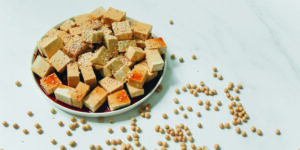
Dr Gemma Newman


If you want to get your gut in order, Dr Will Bulsiewicz is the expert to help you sort out fact from fiction. This is the gut-health cheat sheet...
In the fast-paced and demanding world we live in, finding moments of stillness and calm can be challenging. In an attempt to find a little peace...
Cool off this summer with this delicious wattleseed-flavoured ice cream.
The combination of crushed pineapple and desiccated coconut in these delectable cupcakes is like a bite of tropical paradise.
Summertime means salad season! Load 'em up generously and dress them deliciously.
Jackfruit and chickpeas combine with umami seasoning and a divine creamy caper berry dressing to make this sophisticated and satisfying sandwich,...
Antioxidants are the backbone of a strong immune system and this delicious smoothie contains some of our strongest antioxidant foods. Kakadu...
Enjoy it as a snack, dessert, or even breakfast – you won't be able to get enough of this treat!
The tastiest smoothie you can make, loaded with the yummiest ingredients around. Find your inner child and go wild!
Spraying sheets and pillows with calming scents can be a wonderful aid to slumber
The next time you go for a walk, discover the wonder of the everyday world around you
A skincare routine can be a way to nourish yourself inside and out
When the clouds converge, practise gratitude for the smallest of glimmers, and learn to dance in the rain.
Many common health complaints are caused by hormone imbalances. It may surprise you to learn that what you eat can help or hinder in this important balancing act.
Typical Western diets, lacking in nutrient-dense wholefoods, miss out the vital building blocks we need for keeping our hormones in check. But it doesn’t have to be this way. You can start to take back control and create balance for your hormones with the help of your fork.
Let’s look at some common health issues related to hormonal balance, and what you can do to help alleviate symptoms.
In Western countries, girls are starting their periods younger, and women are tending to go through menopause later. This means lifetime exposure to the female sex hormone oestrogen is extended, putting women at increased risk of hormone-dependent cancers.
Oestrogen is vital; however, not in excess. So what can we do about it? Doing what we can to ensure regular bowel movements is a great start. Constipation can make us overexposed to oestrogen. When we get blocked up, those waste products seep back into our bodies through the intestinal wall and are re-metabolised, increasing our hormonal exposure.
A high-fibre diet is useful for hormonal regulation because it increases the size of your stools and makes them softer, helping to keep you regular. Fibre will also lower cholesterol, keep you feeling full for longer, and is important for gut health, which has other knock-on benefits for overall wellbeing. There are many different types of fibre in nature – all derived from plants. To benefit most, aim to include a wide variety of wholegrains, legumes, nuts, seeds, fruits, and vegetables (skin on where possible).
Animal products, processed foods, and added oils increase your levels of oestrogen, in part because they are inflammatory. The more of these foods you consume, the more likely your uterine lining will become abnormally thick. As a result, when it begins to break down during the menstrual cycle, this process creates more prostaglandins. Painful periods are often caused by these hormone-like lipids that make your uterus contract to help get rid of its lining.
Conversely, a meat-free eating pattern has been shown to decrease inflammation. One study demonstrated that a healthy, plant-based diet significantly reduced the intensity and duration of period pain. The effect of the diet was so powerful that some participants refused to switch back to their regular diet to complete the study.
Interestingly, there are vitamin D receptors in the womb, and it is thought vitamin D could be helpful to reduce prostaglandins and therefore period pain. Ginger, best known as a calming remedy for an upset stomach, has also proven effective for period pain. In one study, it was shown to be as effective as two different types of anti-inflammatory painkillers. Curcumin, an active compound in turmeric, also has benefits due to polyphenols, and is recommended.
To alleviate period pain, try eating lots of fibre-rich foods plus good amounts of turmeric and ginger just before your period starts and throughout, as well as adding a vitamin D supplement if your levels are low. This may provide some big improvements within just a few cycles.
In Australia, polycystic ovarian syndrome (PCOS) affects around one in 10 women of reproductive age and around one in five First Nations women. It is a common cause of fertility difficulties and can also be a risk factor for pre-diabetes, gestational diabetes, and type 2 diabetes. Symptoms include irregular ovulation, erratic periods, weight gain, and acne.
PCOS is a condition fuelled primarily by insulin resistance, and many of the same strategies that apply to diabetes management can also minimise the effects of PCOS. Once again, fibre is king. Foods high in fibre will combat insulin resistance by slowing down the rate of digestion, in turn regulating blood sugar. Processed foods void of nutrients, such as white flour, sugar-sweetened drinks, cakes, and other treats should be minimised. If you are craving something sweet, try reaching for a piece of fibre-packed fruit instead.
Organic, non-GMO soy foods like tofu and edamame can improve many aspects of PCOS, including reduced triglycerides, blood sugars, body weight, and insulin levels. Soy also has a high polyphenol content. Polyphenols are a family of plant-based compounds with a wide range of anti-inflammatory and antioxidant capacities. Because chronic, low-grade inflammation is common for PCOS sufferers, this is desirable.
Hot flushes, insomnia, sexual dysfunction, vaginal dryness, mood changes, and weight gain are all associated with ‘the change’. But do we have to accept this as a part of life? No. There are many ways to deal with these symptoms, including medical treatments, lifestyle changes, and food choices.
A series of interviews with women in the US, Canada, and Japan, conducted by anthropologist Margaret McGill, brought interesting insights into menopause. Hot flushes were so infrequent among Japanese women that they did not even have a word for the phenomenon. The only symptom mentioned, other than the cessation of periods, was shoulder stiffness – and men reported this symptom about as often as women did!
Thinking about the traditional Japanese diet, it is based on rice with relatively little meat and no dairy. The hormonal impact of avoiding dairy hormones could play a part here. Also, the Japanese women were slimmer on average, meaning that the oestrogenic effect of fat cells was also minimised. These women tended to eat a lot of soy, in the form of miso soup, tofu, tempeh, and edamame beans.

Soy is a source of complete amino acids but also phytoestrogens. The isoflavones contained in soy – specifically genistein – have been shown in studies to improve menopausal symptoms and bone mineral density, while reducing the risk of breast, prostate, and colon cancers.
Another study that followed Japanese women over time found that those who ate more soy were 68 percent less likely to experience hot flushes than those who did not. However, various studies have had mixed results, and it is likely that overall this may benefit most women, but will not necessarily result in complete elimination of symptoms.
If you or your partner have been diagnosed with a low sperm count, there are simple steps that can improve quality and quantity. Smoking and drinking are two habits to toss. Also, take the time to consider exposure to hormone-disrupting chemicals. Dioxins and heavy metals, which are especially concentrated in plastic-heated foods, farmed fish, and processed meats, have been associated with reduced sperm quality.
Studies have shown an association between reduced sperm count and saturated fat. If you have already said goodbye to animal products, there are only a few plant foods to be aware of that contain saturated fat, such as coconut, coconut oil, palm oil, and palm kernel oil. While reducing or eliminating these foods, also think about optimising vitamin E, selenium, and Coenzyme Q10, which may also be helpful for healthy sperm. You can get these from nuts and seeds.
|
***
The conditions we have looked at here are just some of those that can be mediated by our hormones. It quickly becomes clear there is a common thread to maintaining balance: an eating pattern that avoids animal products, minimises refined or processed foods, and includes an abundance of fibre, antioxidants, phytonutrients, and numerous other health-promoting substances found in whole, plant foods.
If you want to get your gut in order, Dr Will Bulsiewicz is the expert to help you sort out fact from fiction. This is the gut-health cheat sheet...
In the fast-paced and demanding world we live in, finding moments of stillness and calm can be challenging. In an attempt to find a little peace...
Spraying sheets and pillows with calming scents can be a wonderful aid to slumber
The next time you go for a walk, discover the wonder of the everyday world around you
A skincare routine can be a way to nourish yourself inside and out
When the clouds converge, practise gratitude for the smallest of glimmers, and learn to dance in the rain.